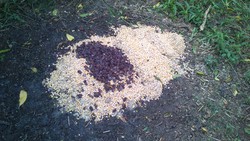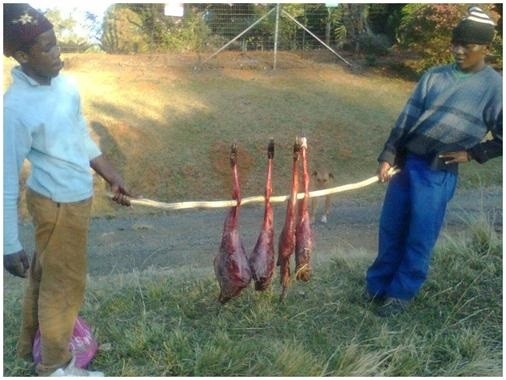Hugh Temple writes:
Whilst conducting a grassland and indigenous forest inspection yesterday morning with Gareth Boothway of the Midlands Conservancy Forum, we came across an area of the indigenous forest which is obviously used by bushpig, bushbuck, duiker etc. On closer examination we found that the place is also being used by humans as a hunting spot for bushpig, bushbuck, duiker etc. A large area has been baited with maize seed and pecan nuts to attract the animals to the area, from where they are shot from a tree nearby, which has been set up with a ladder and a platform of poles about 10 metres up.
 I have spoken to NCT and they have not authorised any hunting in this area and would not. Jeremy Dixon has agreed to send an e-mail to that effect, so we can commence a follow up and possible prosecution. The suspects have been identified as two white males driving a white 4×4 bakkie, who placed the bait at the hide yesterday. We will follow this up with vigour!
I have spoken to NCT and they have not authorised any hunting in this area and would not. Jeremy Dixon has agreed to send an e-mail to that effect, so we can commence a follow up and possible prosecution. The suspects have been identified as two white males driving a white 4×4 bakkie, who placed the bait at the hide yesterday. We will follow this up with vigour!
The picture of the tree hide:
At about 05:55 this morning I was contacted by one of our Worlds View Conservancy members to advise that he had just seen a large group of men hunting with dogs in the grassland section of the Worlds View Conservancy, within a couple of 100 metres of the top end of Tanner Road in Wembley, Pietermaritzburg. Having been a member of SA Can for some time now, at about 06:03 I contacted the National Call Centre, to arrange co-ordinated assistance. I also contacted Mr Linda Zondi of the Msunduzi Municipality Environmental Department.
Whilst waiting for this assistance, I commenced a search for the suspects and found a group of about 8 to 10 men together with more than 15 dogs quite obviously hunting in the area where they had been reported. When they saw my vehicle they scattered in all directions, but I managed to engage in a brief long-distance discussion with them, during which it became obvious that their leader was quite aggressive and confrontational. However, when they realised that I had called for backup and was talking on the cellphone to that backup, they all ran off again towards the thick bush at the top of Tanner Road. It is of interest to note that when this group of poachers is confronted, they run off into as thick a bush as possible and lie down, holding their dogs down and by the muzzle so they don’t make any noise. I carried out a search of the area, but couldn’t find them. Shortly afterwards I was contacted by Constable Barnard of SAPS Prestbury, who was responding to the call from SA Can and was picking his way through the plantation roads (a difficult exercise) to meet up with me. I then made my way to an agreed rendezvous point to meet with Mr Zondi from Msunduzi Municipality ( Cell no: 0837424789) and the SAPS. Throughout this I was in contact with the SA Can Call Centre, co-ordinating the response.
On my way to the rendezvous point I came across one of the dogs, which had obviously been left behind by the group of poachers. On watching him I saw that he was actually tracking the main group. From his behaviour I deduced that the group were now heading in the direction of Sweetwaters. I then met up with the support team of the SAPS and Municipality and agreed on a course of action to continue with patrols of the area to see if the group could be located en route to Sweetwaters. About half an hour later I was advised by Mr Zondi that he had encountered a couple of the group, with two or three dogs, but again they had managed to elude him by scattering into the thick bush. The SAPS team also carried out a thorough search of the route the poachers were likely to follow, without success. In spite of not having managed to apprehend anyone, I am comforted by the fact that the reaction today will provide a deterrent to this type of activity.
This incident serves to illustrate to me how well operations like this can be co-ordinated by a central body, such as SA Can. It ensures that someone like myself, often alone in my interaction with these criminals, has a reassuring, knowledgeable and supportive presence to turn to when assistance is urgently needed. I would also like to express my deep gratitude to Constable Barnard and Warrant Officer Moodley, of Prestbury SAPS, who provided unstinting support, in spite of not being sure they were even in their area of operation, to try and apprehend these criminals. Last, but not least, I would like to thank Mr Linda Zondi, of the Municipal Environmental Department, who never fails to respond quickly to my regular calls for help to deal with these issues, and Doug Burden, a fellow Honorary Officer from the Thurlow Group, who happened to be in the area and responded quickly to my call.
Remains of a previous poaching incident in the area:


W£ell done, Hugh and everyone who supported this effort. Hopefully the perpetrators will eventually be nabbed and locked up.
LikeLike
How lucky are we to have such vigilant protectors of our natural heritage. Thank you!
LikeLike
Hi Nikki,
Well done!!! And thank you for supporting SA CAN. I am also a member and cannot praise them enough. I am sad that not enough people see their value, and therefore don’t support them, and in fact do their best to work against them!!
Best regards
Paula
LikeLike
Ditto to all the above and thank you> regards Phillippa
LikeLike
Thanks to such vigilant and brave folk… Hope the law stops this behaviour.
LikeLike